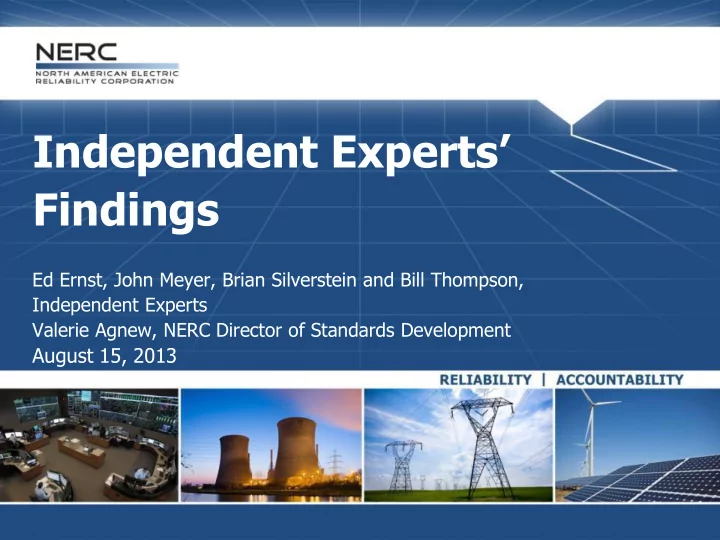

Independent Experts’ Findings Ed Ernst, John Meyer, Brian Silverstein and Bill Thompson, Independent Experts Valerie Agnew, NERC Director of Standards Development August 15, 2013
Key Findings - Gaps • Four high-priority gaps identified Outage coordination Governor frequency response Situational awareness Clear requirements for three-part communication • Three medium-priority gaps identified Verification of accuracy of planning models Short circuit/fault duty models Infrastructure maintenance • Additional gaps identified at the requirement level 2 RELIABILITY | ACCOUNTABILITY
Key Findings - Gaps • Four high-priority gaps identified Outage coordination Governor frequency respons e Situational awareness framework (May be addressed in Project 2009-02) o EMS RTCA models, etc. Clear requirements for three-part communication (Presented to Board) • Three medium-priority gaps identified Verification of accuracy of planning models (Addressed in MOD B) Short circuit/fault duty models (Addressed in MOD B) Infrastructure maintenance • Additional gaps identified at the requirement level 3 RELIABILITY | ACCOUNTABILITY
Key Findings - Gaps • Outage coordination The IRO, EOP and TOP standards do not provide a clear requirement for outage coordination to occur. Outage coordination (of both generation and transmission) sets up the system for reliable real-time operations. Outage coordination needs to extend out for several years. Recommendation: Develop a requirement to address outage coordination. o Proposed “Authority Standard” requires coordination: - R7. Each Reliability Coordinator (RC) shall have the authority and responsibility to develop and implement a generation and transmission outage coordination process across Transmission Operators (TOPs) and Balancing Authorities (BAs) in their footprint. The authority may be delegated (not the responsibility). - R8. Each RC shall have the authority and responsibility to develop and implement a generation and transmission outage coordination process between its adjacent RCs. - R9. The outage coordination process described in R7 and R8 shall cover the time period from the current operating hour out through at least 36 months. 4 RELIABILITY | ACCOUNTABILITY
Key Findings - Gaps • Governor frequency response Adequate governor response is fundamental to adequate Interconnection- wide frequency management. The Independent Experts (IE) team believes there can be an issue related to the geographic dispersal of frequency responsive resources within an interconnection and there is a need to verify appropriate frequency response resources. The new BAL standards require a certain level of frequency performance but do not contain a specific requirement for governor response on the Generator Owner (GO)/Operator (GOP). o BAL-001-2 addresses Real Power Balancing Performance CPS1 and BAAL o BAL-003-1 addresses Frequency Response Measure (FRM) and Frequency Bias Setting 5 RELIABILITY | ACCOUNTABILITY
Key Findings - Gaps • Governor frequency response (cont’d) Approved Planning Committee research recommends the development of a guideline. 2013 NERC State of Reliability Report: frequency response has been steady for past three years. Recommendation: Expand the completed research to address geographic dispersal and verification of governor frequency response resources in a whitepaper with a subsequent determination whether a standard is necessary for accountability. Determine appropriate role for BAs, GOPs, RCs and TOPs. 6 RELIABILITY | ACCOUNTABILITY
Key Findings - Gaps • Situational awareness framework The standards do not provide specific language for real time operators (BAs, TOPs, RCs) to have proper real time situational awareness. The September 2011 SW blackout pointed out the need for proper real time situational awareness tools and processes. Recommendation: Develop a standard that defines the requirements for EMS RTCA models or the performance expectations of the models. o Project 2009-02, Real-Time Monitoring and Analysis Capabilities, may address this topic. o Project 2009-02 has been on hold and was recently re-initiated. 7 RELIABILITY | ACCOUNTABILITY
Key Findings - Gaps • Infrastructure maintenance There are requirements for maintenance of relays and vegetation management but there are no comparable maintenance requirements for other types of transmission equipment (i.e., breakers, transformers, etc.). NERC State of Reliability 2013 key findings #5: o AC Substation Equipment Failures are a Second Significant Contributor to Disturbance Events and Automatic Transmission Outage Severity. o A recent voluntary survey of 2012 transmission outages initiated by failed AC substation equipment indicates: - 29 percent of these outages involved circuit breaker failures, - 16 percent were due to arrester failures and - 15 percent were due to power transformer failures. Recommendation: Address the reliability issue. o The IE team is not recommending that the way to address this is with a mandatory standard. 8 RELIABILITY | ACCOUNTABILITY
Process • RISC discussion • Request for research • RISC determination of appropriate solution 9 RELIABILITY | ACCOUNTABILITY
10 RELIABILITY | ACCOUNTABILITY
Recommend
More recommend